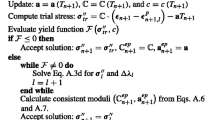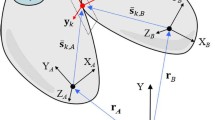Abstract
In this paper, we present a computational framework for the simulation of coupled flow and reservoir geomechanics. The physical model is restricted to Biot’s theory of single-phase flow and linear poroelasticity, but is sufficiently general to be extended to multiphase flow problems and inelastic behavior. The distinctive technical aspects of our approach are: (1) the space discretization of the equations. The unknown variables are the pressure, the fluid velocity, and the rock displacements. We recognize that these variables are of very different nature, and need to be discretized differently. We propose a mixed finite element space discretization, which is stable, convergent, locally mass conservative, and employs a single computational grid. To ensure stability and robustness, we perform an implicit time integration of the fluid flow equations. (2) The strategies for the solution of the coupled system. We compare different solution strategies, including the fully coupled approach, the usual (conditionally stable) iteratively coupled approach, and a less common unconditionally stable sequential scheme. We show that the latter scheme corresponds to a modified block Jacobi method, which also enjoys improved convergence properties. This computational model has been implemented in an object-oriented reservoir simulator, whose modular design allows for further extensions and enhancements. We show several representative numerical simulations that illustrate the effectiveness of the approach.





















Similar content being viewed by others
References
Aadnoy BS, Ong S (2003) Introduction to the special issue on Borehole Stability. J Pet Sci Eng 38:79–82
Allen DR (1968) Physical changes of reservoir properties caused by subsidence and repressurizing operations, Wilmington field, California. J Pet Technol 20(1):23–29
Armero F (1999) Formulation and finite element implementation of a multiplicative model of coupled poro-plasticity at finite strains under fully saturated conditions. Comput Methods Appl Mech Eng 171:205–241
Armero F, Simo JC (1992) A new unconditionally stable fractional step method for coupled thermomechanical problems. Int J Numer Methods Eng 35:737–766
Axelsson O (1994) Iterative solution methods. Cambridge University Press, Cambridge
Babuška I (1973) The finite element method with Lagrangian multipliers. Numer Math 20:179–192
Biot MA (1941) General theory of three-dimensional consolidation. J Appl Phys 12:155–164
Brenner SC, Scott LR (1994) The mathematical theory of finite element methods, volume 15 of Texts in Applied Mathematics. Springer, Heidelberg
Brezzi F (1974) On the existence, uniqueness and approximation of saddle point problems arising from Lagrange multipliers. RAIRO Anal Numér 8:129–151
Brezzi F, Fortin M (1991) Mixed and hybrid finite element methods, volume 15 of Springer Series in Computational Mathematics. Springer, Heidelberg
Chin LY, Raghavan R, Thomas LK (2000) Fully coupled analysis of well responses in stress-sensitive reservoirs. SPE Reserv Eval Eng 3(5):435–443
Coussy O (1991) Mechanics of Porous Media. Wiley, Chichester, 1995. Originally published in French as Mécanique des Milieux Poreux, Editions Technip
Dean RH, Gai X, Stone CM, Minkoff SE (2006) A comparison of techniques for coupling porous flow and geomechanics. Soc Pet Eng J 11(1):132–140
Fredrich JT, Arguello JG, Deitrick GL, de Rouffignac EP (2000) Geomechanical modeling of reservoir compaction, surface subsidence, and casing damage at the Belridge diatomite field. SPE Reserv Eval Eng 3(4):348–359
Gutierrez M, Lewis RW, Masters I (2001) Petroleum reservoir simulation coupling fluid flow and geomechanics. SPE Reserv Eval Eng 4(3):164–172
Han G, Stone T, Liu Q, Cook J, Papanastasiou P (2005) 3-D elastoplastic FEM modelling in a reservoir simulator. In: SPE Reservoir Simulation Symposium, Houston, 31 January–2 February 2005. (SPE 91891)
Hermansen H, Thomas LK, Sylte JE, Aasboe BT (1997) Twenty five years of Ekofisk reservoir management. In: SPE Annual Technical Conference and Exhibition, San Antonio, 5–8 October 1997. (SPE 38927)
Huang M, Zienkiewicz OC (1998) New unconditionally stable staggered solution procedures for coupled soil-pore fluid dynamic problems. Int J Numer Methods Eng 43:1029–1052
Jha B (2005) A mixed finite element framework for modeling coupled fluid flow and reservoir geomechanics. MS Thesis, Petroleum Engineering, Stanford University
Langtangen HP (2003) Computational partial differential equations: numerical methods and Diffpack programming, 2nd edn. Springer, Heidelberg
Lewis RW, Schrefler BA (1998) The finite element method in the static and dynamic deformation and consolidation of porous media, 2nd edn. Wiley, Chichester
Lewis RW, Sukirman Y (1993) Finite-element modeling of 3-phase flow in deforming saturated oil-reservoirs. Int J Numer Anal Methods Geomech 17(8):577–598
Li X, Mitchum FL, Bruno M, Patillo PD, Willson SM (2003) Compaction, subsidence, and associated casing damage and well failure assessment for the Gulf of Mexico shelf Matagorda Island 623 field. In: SPE Annual Technical Conference and Exhibition, Denver, 5–8 October 2003. (SPE 84553)
Li X, Zienkiewicz OC (1992) Multiphase flow in deforming porous media and finite element solutions. Comput Struct 45(2):211–227
Liu Q, Stone T, Han G, Marsden R, Shaw G (2004) Coupled stress and fluid flow using a finite element method in a commercial reservoir simulator. In: SPE Asia Pacific Oil and Gas Conference and Exhibition, Perth, 18–20 October 2004. (SPE 88616)
Minkoff SE, Stone CM, Bryant S, Peszynska M, Wheeler MF (2003) Coupled fluid flow and geomechanical deformation modeling. J Pet Sci Eng 38:37–56
Osorio JG, Chen H-Y, Teufel LW, Shaffer S (1998) A two-domain, 3D, fully coupled fluid-flow/geomechanical simulation model for reservoirs with stress-sensitive mechanical and fluid-flow properties. In: SPE/ISRM Eurock ’98, Trondheim, 8–10 July 1998. (SPE/ISRM 47397)
Park KC (1983) Stabilization of partitioned solution procedure for pore fluid–soil interaction analysis. Int J Numer Methods Eng 19(11):1669–1673
Raviart PA, Thomas JM (1977) A mixed finite element method for second order elliptic problems. In: Galligani I, Magenes E (eds) Mathematical aspects of the finite element method, volume 606 of Lecture Notes in Mathematics. Springer, Heidelberg, pp 292–315
Settari A, Mourits FM (1998) A coupled reservoir and geomechanical simulation system. Soc Pet Eng J 3(3):219–226
Settari A, Walters DA (2001) Advances in coupled geomechanical and reservoir modeling with applications to reservoir compaction. Soc Pet Eng J 6(3):334–342
Shaw G, Stone T (2005) Finite volume methods for coupled stress/fluid flow in a commercial reservoir simulator. In: SPE reservoir simulation symposium, Houston, 31 January–2 February 2005. (SPE 93430)
Simo JC, Hughes TJR (1998) Computational inelasticity, volume 7 of Interdisciplinary Applied Mathematics. Springer, Heidelberg
Stone T, Bowen G, Papanastasiou P, Fuller J (2000) Fully coupled geomechanics in a commercial reservoir simulator. In: SPE European petroleum conference, Paris, 24–25 October 2000. (SPE 65107)
Stone TW, Xian C, Fang Z, Manalac E, Marsden R, Fuller J (2003) Coupled geomechanical simulation of stress dependent reservoirs. In: SPE Reservoir Simulation Symposium, Houston, 3–5 February 2003. (SPE 79697)
Terzaghi K (1943) Theoretical soil mechanics. Wiley, New York
Thomas LK, Chin LY, Pierson RG, Sylte JE (2003) Coupled geomechanics and reservoir simulation. Soc Pet Eng J 8(4):350–358
Tran D, Settari A, Nghiem L (2002) New iterative coupling between a reservoir simulator and a geomechanics module. In: SPE/ISRM rock mechanics conference, Irving, 20–23 October 2002. (SPE 78192)
Wan J (2002) Stabilized finite element methods for coupled geomechanics and multiphase flow. PhD Dissertation, Petroleum Engineering, Stanford University
Wan J, Durlofsky LJ, Hughes TJR, Aziz K (2003) Stabilized finite element methods for coupled geomechanics–reservoir flow simulations. In: SPE reservoir simulation symposium, Houston, 3–5 February 2003. (SPE 79694)
Wang HF (2000) Theory of linear poroelasticity. Princeton University Press, Princeton, New Jersey
Zienkiewicz OC, Paul DK, Chan AHC (1988) Unconditionally stable staggered solution procedure for soil–pore fluid interaction problems. Int J Numer Methods Eng 26(5):1039–1055
Zoback MD, Barton CA, Brudy M, Castillo DA, Finkbeiner T, Grollimund BR, Moos DB, Peska P, Ward CD, Wiprut DJ (2003) Determination of stress orientation and magnitude in deep wells. Int J Rock Mech Min Sci 40:1049–1076
Acknowledgments
The authors are thankful for financial support from the members of the affiliate program of the Stanford University Petroleum Research Institute for Reservoir Simulation (SUPRI-B). Partial support was also provided by Foundation CMG; this support is gratefully acknowledged.
Author information
Authors and Affiliations
Corresponding author
Rights and permissions
About this article
Cite this article
Jha, B., Juanes, R. A locally conservative finite element framework for the simulation of coupled flow and reservoir geomechanics. Acta Geotech. 2, 139–153 (2007). https://doi.org/10.1007/s11440-007-0033-0
Received:
Accepted:
Published:
Issue Date:
DOI: https://doi.org/10.1007/s11440-007-0033-0




